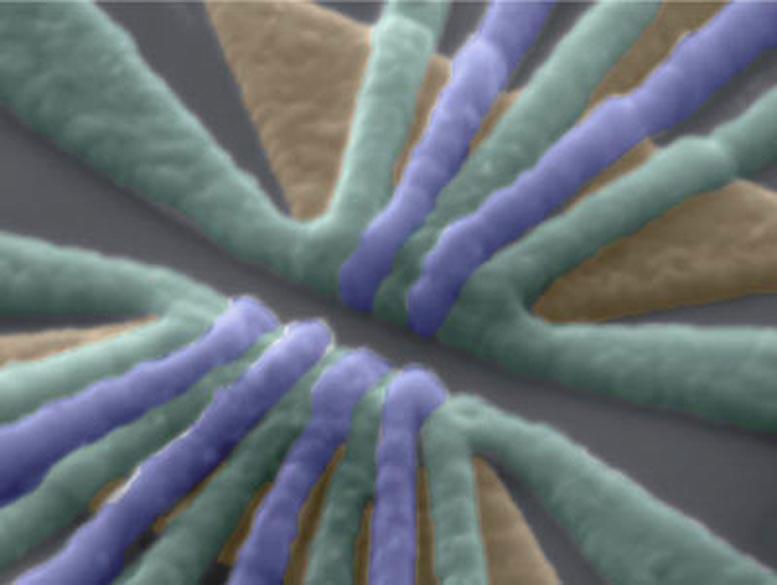Circa 1994 intergalactic solid state telecommunications: 3.
Read [title]title].


Quantum computers in regular logical computers.
Quantum teleportation and quantum error correction play crucial roles in fault-tolerant quantum computing. Here, we implemented error-correctable quantum teleportation to manipulate a logical qubit and observed the protection of quantum information. Our work presents a useful technology for scalable quantum computing and can serve as a quantum simulator for holographic quantum gravity.
Quantum error correction is an essential tool for reliably performing tasks for processing quantum information on a large scale. However, integration into quantum circuits to achieve these tasks is problematic when one realizes that nontransverse operations, which are essential for universal quantum computation, lead to the spread of errors. Quantum gate teleportation has been proposed as an elegant solution for this. Here, one replaces these fragile, nontransverse inline gates with the generation of specific, highly entangled offline resource states that can be teleported into the circuit to implement the nontransverse gate. As the first important step, we create a maximally entangled state between a physical and an error-correctable logical qubit and use it as a teleportation resource. We then demonstrate the teleportation of quantum information encoded on the physical qubit into the error-corrected logical qubit with fidelities up to 0.786.



StoreDot, an Israeli developer of extreme fast-charging (XFC) battery technology for electric vehicles, unveiled this month what it called the “world’s first” silicon-dominant battery prototype capable of recharging in just 10 minutes.
The company’s cylindrical cells use a 4,680 format — 46 millimeters wide by 80 millimeters long — that is favored by global carmakers, specifically electric vehicle giant Tesla.
The battery tech has been in development for three years and includes five patents in cell design, StoreDot said in a statement last week. The design “increases throughput and addresses safety and performance issues typically associated with the hard case structure of cylindrical cells,” the company said.

The long-awaited $355 million development of Little Island New York has finally been made reality, offering the Big Apple a unique new space.
Although it’s unlikely travel to the US will be on the cards for Aussies anytime soon, it’s good to keep track of the developments that await us when we eventually graduate from tiny travel bubbles to full-scale international adventure once again. The latest development: the ambitious new US$260 million (AU$335 million) Little Island New York, an offshore public park in the Hudson River that has been one of the city’s most anticipated openings for a couple of years now.
Located at Pier 55 the fascinating public park has been designed to resemble a supersized leaf drifting on the Hudson, buoyed by a base of 280 concrete piles and precast columns driven down as far as 60 metres below water, as well as 132 tulip-shaped concrete pots positioned at various elevations from 4 metres to 18 metres above water, designed specifically by Heatherwick Studio, and developed by engineering firm Arup, to hold the soil, overlooks, and trees. This support base allows for the two-acre park to stay securely afloat so its 687-seat amphitheatre, smaller stage, and plaza don’t suddenly drop to the depths of the Hudson.
The waterborne engineering is almost as fascinating as the park itself, but it’s what’s on top this mini-island that represents what many reports are (hopefully not naively) likening to a bridge between New York City’s pre-and post-COVID era.

CERN Courier
Jennifer Ngadiuba and Maurizio Pierini describe how ‘unsupervised’ machine learning could keep watch for signs of new physics at the LHC that have not yet been dreamt up by physicists.
In the 1970s, the robust mathematical framework of the Standard Model ℠ replaced data observation as the dominant starting point for scientific inquiry in particle physics. Decades-long physics programmes were put together based on its predictions. Physicists built complex and highly successful experiments at particle colliders, culminating in the discovery of the Higgs boson at the LHC in 2012.
Along this journey, particle physicists adapted their methods to deal with ever growing data volumes and rates. To handle the large amount of data generated in collisions, they had to optimise real-time selection algorithms, or triggers. The field became an early adopter of artificial intelligence (AI) techniques, especially those falling under the umbrella of “supervised” machine learning. Verifying the SM’s predictions or exposing its shortcomings became the main goal of particle physics. But with the SM now apparently complete, and supervised studies incrementally excluding favoured models of new physics, “unsupervised” learning has the potential to lead the field into the uncharted waters beyond the SM.

Reasoning is an ability that is unique to human cognition. However, despite our advances in neuroimaging techniques, we cannot clearly map the neural regions involved in human reasoning. In a new study, researchers from Korea came up with a new approach to understand the foundations of both inductive and deductive reasoning and identify the major brain areas responsible, paving the way for uncovering the mechanisms of various other cognitive processes.
One of the factors that make us uniquely “human” is our ability to reason, i.e., to cognitively analyze situations, predict possible outcomes, and make decisions accordingly. Broadly speaking, human reasoning can be classified as “inductive,” which involves making predictions based on existing knowledge, and “deductive,” in which definitive conclusions are reached from given premises. However, despite the cutting-edge technology we have at our disposal, neuroscientists are yet to pinpoint where this ability stems from.
Scientists typically use a global approach called “meta-analysis,” a statistical method combining results of previous studies to derive conclusions. However, meta-analyses in this field have not adequately accounted for the complex folded geometry of the cortical surface (the surface of the two brain hemispheres).


A three-qubit entangled state has been realized in a fully controllable array of spin qubits in silicon.
An all-RIKEN team has increased the number of silicon-based spin qubits that can be entangled from two to three, highlighting the potential of spin qubits for realizing multi-qubit quantum algorithms.
Quantum computers have the potential to leave conventional computers in the dust when performing certain types of calculations. They are based on quantum bits, or qubits, the quantum equivalent of the bits that conventional computers use.